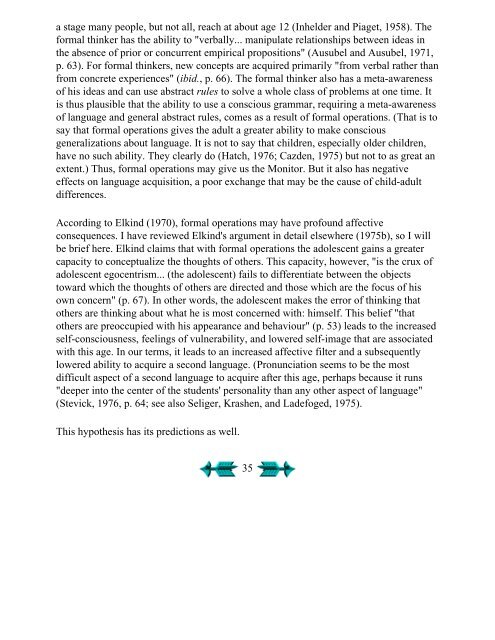Second Language Acquisition and Second ... - Stephen Krashen
Second Language Acquisition and Second ... - Stephen Krashen
Second Language Acquisition and Second ... - Stephen Krashen
Create successful ePaper yourself
Turn your PDF publications into a flip-book with our unique Google optimized e-Paper software.
a stage many people, but not all, reach at about age 12 (Inhelder <strong>and</strong> Piaget, 1958). The<br />
formal thinker has the ability to "verbally... manipulate relationships between ideas in<br />
the absence of prior or concurrent empirical propositions" (Ausubel <strong>and</strong> Ausubel, 1971,<br />
p. 63). For formal thinkers, new concepts are acquired primarily "from verbal rather than<br />
from concrete experiences" (ibid., p. 66). The formal thinker also has a meta-awareness<br />
of his ideas <strong>and</strong> can use abstract rules to solve a whole class of problems at one time. It<br />
is thus plausible that the ability to use a conscious grammar, requiring a meta-awareness<br />
of language <strong>and</strong> general abstract rules, comes as a result of formal operations. (That is to<br />
say that formal operations gives the adult a greater ability to make conscious<br />
generalizations about language. It is not to say that children, especially older children,<br />
have no such ability. They clearly do (Hatch, 1976; Cazden, 1975) but not to as great an<br />
extent.) Thus, formal operations may give us the Monitor. But it also has negative<br />
effects on language acquisition, a poor exchange that may be the cause of child-adult<br />
differences.<br />
According to Elkind (1970), formal operations may have profound affective<br />
consequences. I have reviewed Elkind's argument in detail elsewhere (1975b), so I will<br />
be brief here. Elkind claims that with formal operations the adolescent gains a greater<br />
capacity to conceptualize the thoughts of others. This capacity, however, "is the crux of<br />
adolescent egocentrism... (the adolescent) fails to differentiate between the objects<br />
toward which the thoughts of others are directed <strong>and</strong> those which are the focus of his<br />
own concern" (p. 67). In other words, the adolescent makes the error of thinking that<br />
others are thinking about what he is most concerned with: himself. This belief "that<br />
others are preoccupied with his appearance <strong>and</strong> behaviour" (p. 53) leads to the increased<br />
self-consciousness, feelings of vulnerability, <strong>and</strong> lowered self-image that are associated<br />
with this age. In our terms, it leads to an increased affective filter <strong>and</strong> a subsequently<br />
lowered ability to acquire a second language. (Pronunciation seems to be the most<br />
difficult aspect of a second language to acquire after this age, perhaps because it runs<br />
"deeper into the center of the students' personality than any other aspect of language"<br />
(Stevick, 1976, p. 64; see also Seliger, <strong>Krashen</strong>, <strong>and</strong> Ladefoged, 1975).<br />
This hypothesis has its predictions as well.<br />
35











